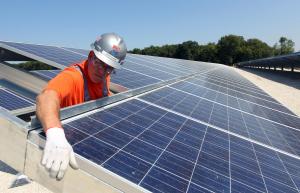April 30 (UPI) — With the solar power industry growing, there are now a range of solar panels available on the market, complicating installation decisions. Should buyers go with the newest and most efficient, but more expensive, solar panels or the older, cheaper models?
Researchers at MIT have developed a simple formula to determine which solar panels will work best for a given setup.
The formula considers two types of solar panel: a basic design featuring a single kind of photovoltaic material, or the cheap option, and tandem cells, higher-efficiency panels featuring two types of photovoltaic material. Researchers also weighed the economics of two different types of tandem cells, two-junction cells, which are integrated into a single series, and four-junction cells, which are wired separately.
The formula — detailed this week in the journal Nature Energy — weighs each unit’s output over its lifespan, given the expected conditions at an installation site, against the costs of installation and maintenance. Researchers used the combined arithmetic to spit out a measure of economic efficiency called levelized cost of electricity, or LCOE.
“Standard single-junction cells have a maximum efficiency limit of about 30 percent,” grad student Sarah Sofia told MIT News. “Tandem cells, using two materials, can have much higher efficiency, above 40 percent.”
Tandem cells have an obvious performance advantage, but they are more expensive manufacture, install and maintain. LCOE can help homeowners and energy companies figure out if they’re worth the extra costs.
The formula showed that whether tandem cells’ high-performance tech pays off depends on the type of installation and where it’s being installed.
Researchers used their formula to determine which type of cell would perform best in three different locations: Arizona’s arid climate, South Dakota’s temperate climate and Florida’s humid climate. Water vapor can hinder the amount of sunlight that is absorbed by solar cells.
Researchers and their formula also considered whether the cells were part of a smaller, residential installation or a larger, commercial setup.
“For residential systems, we showed that the four-terminal tandem system [the most efficient solar cell available] was the best option, regardless of location,” Sofia said.
However, the formula showed that for large-scale operations, the cheapest option offered the greatest economic benefit.
“For me, showing that a four-terminal tandem cell had a clear opportunity to succeed was not obvious. It really shows the importance of having a high energy yield in a residential system,” Sofia said.
Researchers say their work could be used to weigh the economic costs and benefits of other variables related to solar panel technology, and could also be used to determine where to funnel solar panel research funding in order to get the greatest return on investment.
The growth of the solar energy industry has accelerated in the U.S. over the last decade. Solar and wind projects accounted for 62 percent of all new energy building projects in 2017. But there is some uncertainty over the prospects of the residential market, and reports suggest solar energy companies are looking to scale back expansion in favor of beefing up their most efficient and profitable operations. MIT’s new formula could help solar energy companies pinpoint where and how to allocate their resources.

COMMENTS
Please let us know if you're having issues with commenting.